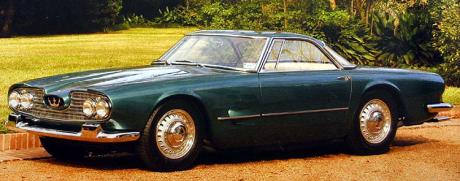
The beginning of this story could come straight out of the Charles Dickens’ classic slog-fest A Tale Of Two Cities. “It was the best of times, it was the worst of times…” The year 1957 should have been cause for celebration at Maserati with both the world championship for Formula One cars, and the championship for sports cars coming home to Modena (to which the company had relocated from Bologna in 1940). As it happened, Juan Manuel Fangio was able to secure the F1 championship against Ferrari with a stunning win at Nurbergring in his 250F, but at the last sportscar race of the season, in Caracas, Venezuela, both of Maserati’s remaining 450S sports-racers were destroyed. Maserati had already decided to withdraw from competition at the end of the season when it became known that the FIA was to implement rule changes that would make the 450S obsolete. Now though, the firm now faced extinction as the 450s that were destroyed in the race had already been sold…
By early 1958 the situation had improved somewhat with the introduction and success of the 3500 GT, but Maserati were still stuck with a useless stock of spare engines for the destroyed and outlawed 450S. The solution, as if often the case, came unlooked for in the person of Mohammad Reza Pahlavi, who did not yet know he was to be the last Shah of Iran. On a visit to the factory in 1958, The Shah had been impressed by Maserati’s new 3500 GT sports car. To a man supported by nearly unlimited income however, the car seemed just a little too plain, there was room for improvement, and so the chassis of the 3500 GT, would be combined with a bored-out version of the 450S racing motor to create a car worthy of kings, the Maserati 5000 GT.
Of course, that’s not what it was called at the time. The factory gave the new project the name of Tipo 103, while Carrozzeria Touring, to whom it fell to style the car, named it “Scia di Persia.” At first Maserati had sort of thought that was that. Who, they wondered, would be able or willing to pay the astronomical price of such a car? As it turned out, about thirty people including Karim Aga Khan, Briggs Cunningham, and Mexican President Adolfo Lopez Mateos wanted, and could afford the car, and so Maserati began producing the chassis and engines to order. Once the initial supply of 405S motors ran out, a new, closely related engine was designed, with slightly different capacity, and chain-driven camshafts instead of the racer’s gear-drive. Some cars came with four Webber carburetors, others were supplied with Lucas fuel injection. Production ran for about seven years.
The term “custom made” gets thrown around a lot these days, but it certainly applied to these cars, of the thirty, no two are exactly alike, and though some 22 recieved similar bodies by Allemano, the rest were spread out over the great coach-builders of Europe. These were almost undoubtedly the fastest cars of their day with confirmed top speeds hovering around the 170mph mark depending on aerodynamics. That’s a speed that would still have been respectable for a super-car in the early 1980s.
The Shah’s car is pictured above, and from this angle you can see what is probably its least successful feature, that being the somewhat strange grill treatment so reminiscent of a cleft lip. The rest of the car is beautifully judged though, and the interior is relatively simple and elegant compared to others of the line. The color too is impressively restrained, though the white upholstery bespeaks the status of a man who has servants to clean such things. For me, the lone Pinin Farina car, or those of Ghia or Allemano work better.
The reign of the last Shah and its end are subjects for another time, and for deeper men than I. Likewise, whether cars such as this are spoils of tyrants, or the rightful perks of empire can be discussed at length, by someone else. To me, it is only a marvelous object, to be appreciated for itself. The Scia di Persia and its brethren are wonderful things. Beautiful, fast, unique, they belong more to those who created them, than to those who paid for them to be created.






